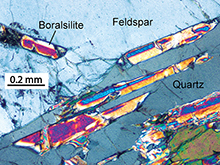News
Antarctic minerals new to science
Published:27 June 2014
Antarctic minerals new to science

A microscopic view of brightly
coloured crystals of boralsilite
surrounded by quartz and feldspar.
The name boralsilite comes from the
composition of the mineral which is
almost entirely composed of boron,
aluminium, and silicon. Image
credit: Ed Grew and Chris Carson
Some very special Antarctic rocks, containing rare minerals which have never been found anywhere else on Earth, will now be protected under international treaty.
The Stornes Peninsula in the Larsemann Hills region in East Antarctica was recently designated as an Antarctic Specially Protected Area. This determination recognises the region's outstanding geological significance and gives it the highest level of environmental protection under the Antarctic Treaty's Protocol on Environmental Protection.
Historically Antarctic conservation efforts have focussed on sites of biological or cultural significance, whereas sites of geological significance, in general, have been underrepresented.
Geologist Dr Chris Carson, head of Geoscience Australia's Antarctic Geoscience program said this protection is geologically exciting as Stornes Peninsula is home to a spectacular abundance and diversity of extremely rare minerals.
"Four of these minerals: boralsilite, stornesite, chopinite and tassieite; are entirely new to science; three of which have not been found anywhere else on Earth," Dr Carson added.
"Stornes Peninsula is known as a 'type locality' for these four new minerals, which is the location where a new mineral is first described," Dr Carson explained.
"In addition to these four new minerals there are many more minerals, such as prismatine, grandidierite and wagnerite to name a few, that while rare globally, are actually quite abundant in the Larsemann Hills region."
Studying these minerals also provides a unique and unusual insight into the geological evolution of the region.
This newly declared protected area demonstrates the importance of Antarctic geoscience research in support of Australia's international environmental objectives under the Antarctic Treaty System.
The collaborative work which supported the submission for protection of Stornes Peninsula was undertaken by the Australian Antarctic Division and Geoscience Australia in conjunction with Dr Edward Grew, a specialist in rare minerals from the University of Maine. The protected area proposal was led by Australia and jointly sponsored by other nations who also have research programs in the broader Larsemann Hills region, including China, India and the Russian Federation.
The proposal was adopted at the Antarctic Treaty Consultative Meeting held recently in Brazil. This decision reflects international acknowledgement of the region's outstanding geological significance, and the potential vulnerability of these remarkable mineral occurrences to human disturbance.
Contact:
Phone:
Email:




